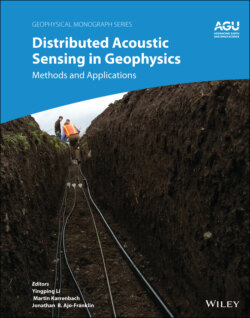Читать книгу Distributed Acoustic Sensing in Geophysics - Группа авторов - Страница 61
3.2.4. System Configuration and Working Principle of the DMOF‐DAS
ОглавлениеThe experimental setup is illustrated in Figure 3.6a. A typical coherent OTDR structure is adopted and the DMOF is used as the functional unit test (FUT) for sensing, both of which can improve the SNR of the acoustic sensing signals. A 40‐mW laser source with a narrow linewidth of less than 1 kHz is split into two parts by the coupler with a splitting ratio of 1:99. One part serves as the local oscillate signal, and the other part is modulated into pulse with a duration time of 20 ns and frequency shifted with 200 MHz by the acoustical optical modulator (AOM). The erbium‐doped fiber amplifier (EDFA) amplifies the average power of the pulse and pours the pulse into the FUT through the circulator. The backscattering light from the DMOF, which carries external acoustic information, is mixed with the local light and detected by the balanced photodetector (BPD) to generate the heterodyne beat frequency signal. It should be noted that, owing to the high SNR of backscattering light from the DMOF, only one amplifier is needed and inserted between the AOM and optical circulator, which is simpler than the SMF‐based DAS interrogator. Then the electrical signal from the BPD is collected by a DAQ card. In order to sample the coherent signal of 200 MHz precisely, the acquisition speed of the DAQ is set as high as 2 GS/s. Then the acquired data are multiplied with the reference signal as the in‐phase and quadrature (IQ) demodulation scheme to extract the phase information along the fiber.
Figure 3.6 Working principle of DMOF‐DAS: (a) System configuration and (b) phase extraction workflow.
The phase extraction process is described in detail as follows. The reflected light generated by the ith backscattering enhanced point can be expressed as:
(3.1)
While the electric field intensity of the local oscillator can be described as:
(3.2)
Therefore, the signal received by the BPD can be represented as:
(3.3)
Where asi and aL are the amplitudes of the pulse signal from the ith microstructure and the local oscillator, respectively, S is the responsibility of the BPD, Δf = fS − fL = 200 MHz is the frequency shift of the probe pulse, and φi = φsi − φL is the phase difference between the signal light from the ith microstructure and the local oscillator. The frequency shift of 200 MHz could move the sensing signal to a high‐frequency band, which is beneficial in eliminating the low‐frequency noise. As shown in Figure 3.6b, a band‐pass filter (BPF) with center frequency at 200 MHz is used for signal denoising. After band‐pass filtering, the relatively pure beat frequency signal Data(i) can be obtained. In addition, a reference function is developed for phase extraction, as well as its orthogonal function that is generated by the Hilbert transform, which can be expressed as:
(3.4)
(3.5)
Multiply Iri(t) by Iref1 and Iref2, respectively, and then a pair of the orthogonal functions about φi can be obtained after the low‐pass filter (LPF). Furthermore, the differential cross‐multiplying algorithm is employed to calculate the φi, and the following result is obtained:
(3.6)
Then, the phase change of the sensing fiber between ith and (i+1)th backscattering enhanced point can be described as:
(3.7)
Consequently, the amplitude, frequency, and phase of the acoustic wave are represented by the optical phase change Δφi. Notably, here the spatial resolution is decided by the spatial interval of the backscattering enhanced scatters in the DMOF, and Δφi is directly served as the output of each channel without additional moving average algorithm.
